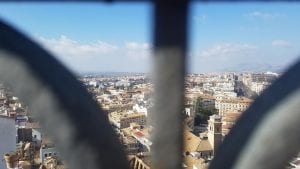For me, the highlight of this adventure in Granada did not actually take place in Spain, but Morocco. While living in Spain did present a massive cultural adjustment, it wasn’t the most different of places for me to be. Other than the language and some European differences, life as a college student in Spain was not much different than in Walla Walla. I’m glad that IES decides to do this five-day trip to Morocco because it offered us a chance to experience something truly different and alter our perspective as global citizens.
We started our first of five days taking an early bus ride three hours south to Algeciras, the port city that serves as the main hub for transportation between Spain and Morocco. After the boat and another bus, we arrived in Tangier where we settled in for the night and ate a delicious meal with the most vegetables I had seen since getting to Spain. The next day we took a quick tour of the city’s downtown and markets and started to get a sense of this culture and lifestyle that came as a surprise to even the travel veterans in our group. We then met up with three female students who volunteer with an organization that helps women find work, housing, education, and stability. We had a lengthy conversation with them where they discussed all aspects of Moroccan life. Their answers to our questions proved both very familiar, such as the anxieties of finding a job after college and dating while still living with their parents, and yet quite different, such as having to be careful not to openly criticize the government and the discrimination that comes along with wearing a hijab. This last point sparked confusion and interest from us when she said it. After all, Morocco was a Muslim country, so why wouldn’t one be allowed to wear a hijab? Morocco, as it turns out, is an incredibly religiously diverse country, with Christians, Jews, and Muslims living together. In efforts to modernize the image of the country, however, anyone who wears a hijab is barred from government service. The student who tells us this wears a hijab herself, and her skills as a translator (she knows English, French, Moroccan Arabic, and Standard Arabic) will have to be put to work somewhere other than the public sector. This was the first of many conversations we were to have with different Moroccans, and was the most profound and interesting aspect of our visit. We did some classic tourist activities, like visiting the Mausoleum of Mohammed V in Rabat and walking the shops of Chefchaouen, but speaking to real people was an experience unique to our program. Anyone can go to Morocco and see the sights, but it’s hard to sit down with people and hear their perspective on the world.
After Tangier we headed to Rabat where we partook in some of the most delightful of tourist activities, like riding a camel on the beach and getting scrubbed down in the hamam, as well as further conversations with local residents. I stayed in a homestay with a family—a woman in her early 30’s and her mother father. The younger woman spoke enough English to communicate but not enough to have any kind of in-depth conversation, but talking, at least with this family, wasn’t that necessary because our meals were spent watching TV, her favorite show being one where Nick Cannon dissects viral videos. The highlight of Rabat was getting to speak to Moroccan college students, who were more than happy to show us their favorite spots around town and answer our questions. I think they enjoyed acting like rebellious Moroccan youth because they made flippant comments about the government to us, saying they don’t care who hears them, but only making these comments in noisy and private places. They also asked us a ton of questions, mostly focusing on parties and drugs and other facts of the American college that they gleaned from movies and television. After Rabat we took a long drive through the mountains to Chefchaouen, stopping at a rural farmhouse along the way to talk with a family. Offering a more conservative viewpoint than the liberal young people we talked to, the husband and wife sat with us and talked about life on the farm, how they met and became married, local healthcare, and their neighbors. They have three kids but both come from very large families of over ten siblings. They had a good laugh when I told them that in America you get a TV show about you if you have 8 kids. We ended our journey in Chefchaouen where we had a more calm day of walking through the markets, having a delicious final meal, and spending a couple hours on the roof with our small group reflecting on our journey. Unsurprisingly everyone had a lot to say about the country, even though we had only been here for a few days. By all accounts we had a structured, pampered, and safe visit to Morocco, but it was still enough for us to gain an appreciation for a people and culture most of us had not considered before. And I’m not talking about just the Moroccan people necessarily, but rather the billions of people living alongside us who do not possess many things or much money but still live life to the absolute fullest and find joy in what they do. Going on this journey made me much more grateful and appreciative of what I have, and I can only hope I will be a more informed and empathetic global citizen.


